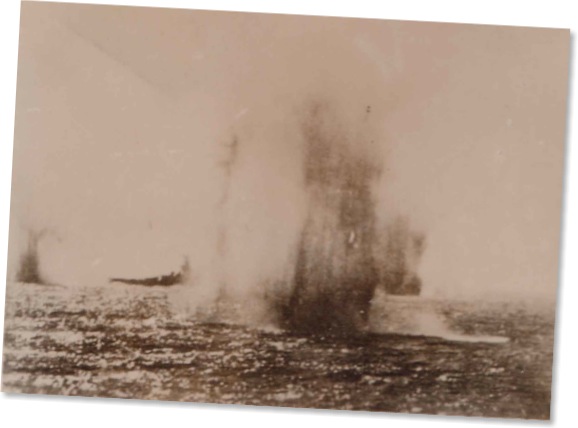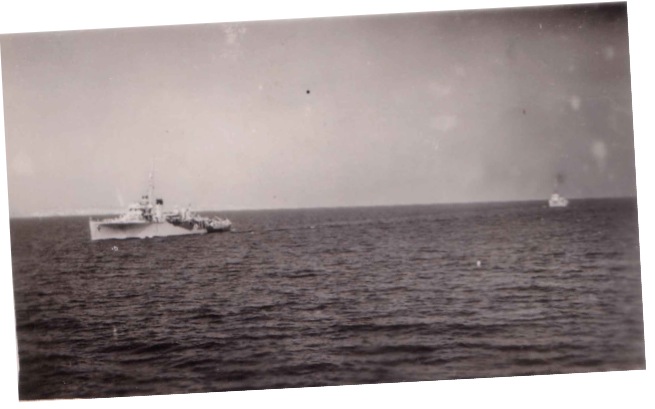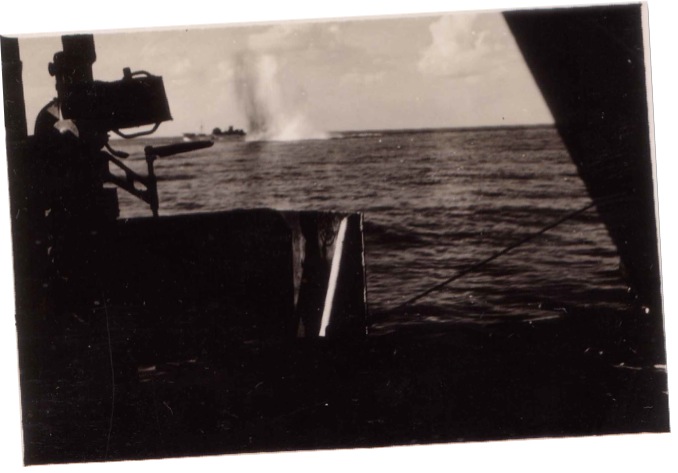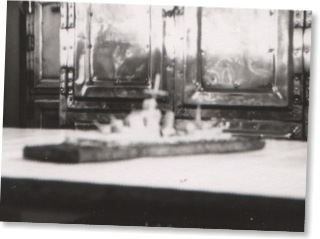I was drafted back to Portsmouth for a gunnery course at Whale Island and on qualifying I was sent to a battleship at Scapa Flow. A couple of days later I was sent to Sheerness to join HMS Speedy, a minesweeper, as gunners mate. On joining the ship I met the Captain and the Buffer (Oscar Littlewood) who said my job would be sweeping deck. I said I have never done any minesweeping and he said “well we have 3 weeks to teach you.” It was suprising how quick one picked up the names of all the gear used – Cutters, Fids, Kites and Otters – and their various uses. As gunners mate it was also my responsibility to check all the ammunition required for the guns – the 4” guns on the forecastle, 2 Oerlikons and machine guns in the bridge area. I also had to ensure there was sufficient rifle ammunition for blowing up cut mines.
After 2 weeks training I had settled fairly well into the new routine (drill) for sweeping the mines (out sweeps). On leaving the dockyard we had about 7 days for testing all sweeping drills which went off OK. After the trials we went back into the dockyard and took onboard lots of extra sweeping spares and we then sailed for Scapa Flow. As we arrived at Scapa Flow the Captain informed us we were joining a Russian convoy. Heavy wear gear was supplied and the Buffer told us that “we would need it” as he had been on a convoy previously. The convoy sailed and we were given our station keeping our position in the convoy. It was not a large convoy but was apparently very urgently required. The usual routine of Action Stations was in operation on sailing. After about an hours sailing we were under attack by Stukas, high level bombing and submarines. We lost at least 2 ships during the night, and more in subsequent attacks whilst we were on route to Iceland. We were NOT allowed to pick up survivors as we would endanger the ship. The survival time in the sea was less than 3 minutes so therefore the people would be dead before they were rescued anyway.
On arrival at Reykjavik in Iceland we received fresh instructions that we had to land all foul weather gear and take on tropical gear instead. After completing this task we were told by HMS Speedy’s Captain that all minesweepers were to sail for Gibraltar which was immediately executed.
The weather was really rough so all spares were checked and really secured. We had a fairly easy passage till about the Bay of Biscay when we were spotted by a German Condor patrol plane but owing to the foul weather we managed to reach Gibraltar with no attacks. It made a nice change to get a run ashore to be able to have a few pints and mingle with people. I think it was a Thursday when we arrived so everything was cleaned up, re-stored and re-fuelled by Saturday. The skipper sent for the Buffer and myself and told us we would probably be going to Malta soon.
It is a fact that very little has been reported of the minesweepers in convoy “Harpoon” that left Gibraltar at midnight on June 14th 1942. We were called to prepare for sea so there was plenty of movement and at about 06:00 we were taking up station for convoy duties. The convoy consisted of about seven merchant ships, 2 aircraft carriers, the battleship HMS Malaya, about six destroyers and four minesweepers – HMS Hebe, HMS Speedy, HMS Rye and HMS Hythe. It was an impressive sight. The convoy got on the move and all was sunshine and bliss. The mess men had just brought up our dinner up to us as we were on Action Stations when the general alarm was given and the attacks started.


We encountered
high level bombings, Stuka and fighter-bomber attacks, low
level attacks by torpedo planes, and submarines that
continued all the way to Malta. The finest sight I ever saw
was an attack on HMS Malaya by 3 torpedo bombers, and her
main armament firing high explosive shells, and the 3
attacking planes simply disappeared out of the sky in the
explosion that followed. In the first couple of days we
lost about 3 ships from the convoy. When we reached the
Pantelleria Straights, the capital ships, HMS Malaya, and a
few of the destroyers left us and wished us “good luck”
leaving us with a city class cruiser and a couple of
destroyers. Just off Pantelleria the tanker “Kentucky” was
disabled and HMS Rye was dispatched to take her in tow but
heavy units of the Italian Navy were sighted so HMS Rye was
ordered to sink the Kentucky instead.

The Italian
Navy opened fire on the convoy but fortunately there were
no casualties. HMS Hebe had a shell pass through the bridge
area but it did not explode. The British cruisers and
destroyers passed us enroute to engage the Italian Navy
with full battle ensigns flying and with their guns firing
– taking on the heavy cruiser of the Italian Navy. However,
as they approached the Italian forces, they down tailed and
ran over the horizon.
We continued to Malta, arriving at Filfa Point, with three
merchant ships. We immediately commenced sweeping the
passage into Valletas Grand Harbour when immediately HMS
Hebe took a mine but she remained afloat. One of the
merchant ships also ran into one that unfortunately sank
her within sight of her destination. We were bringing up
mines all over the place so were very busy changing sweeps.
Due to the fact that HMS Hebe and a merchant ship had hit
mines we were instructed to wait till dawn before
recommencing sweeping.
In the morning we did successfully clear a passage into the
Grand Harbour however we lost one more merchant ship to
mines in the process. On arrival in the harbour we saw the
only remaining merchant ship tie up and then HMS Hebe was
brought in to dock. We had been under constant aerial
bombardment during this entire time.

All of the
minesweepers were berthed at Silema Creek off Manoel Island
where we operated for 18 months keeping the channel open
enabling submarines to operate and occasionally the fast
mine layers HMS Manxman and HMS Welshman to bring in
munitions and supplies. The sweep area was about 10 miles
long by about 3 miles wide and the Germans would lay their
mines under the cover of darkness, so as a result we would
continually sweep the channel from dawn to dusk. During the
18 months we were on station I believe the squadron cleared
more than 350 mines often under aerial bombardment from
German planes returning from bombing Malta.
Whenever any sweeper was required in the docks area for
repair we would evacuate the ship, and sleep in the
dockyard tunnels where accommodation was always available
to us. Both Orliken guns positions on the ship were manned
for any low level attacks. It was a long and depressing 18
months spent sweeping backwards and forwards over the same
area of water whilst being target practice for German
fighter aircraft returning from dropping their bombs on
Malta. After this long 18 months, it was a fantastic sight
to see all of the allied ships arriving for the Relief of
Malta. Later we found out they continued on to the proposed
landing in Italy.

We
had not had any potatoes for the entire time on Malta and
to see sacks of spuds around the Destroyers gun sponsens
acting as protection from splinters was mouth watering
sight. We requested from our Captain permission to visit a
destroyer – which was granted. On boarding the destroyer we
asked for their Buffer or Gunners mate. It was their Buffer
that I saw. We asked him if it was possible to have a few
potatoes.
He asked us why, so we explained we were from HMS Speedy
and that we had not had any fresh potatoes for 18 months.
We asked him if he could spare us some from the backs
surrounding the gun sponsens. He told us he would ask his
1st
Lieutenant to
see if they could. On his return he said that Jimmy – his
1st
Lieutenant had
approved we could have 3 sacks for the ship company. We
thanked him and took the potatoes back to our ship and
informed our 1st
lieutenant of
the gift from the destroyer. Well as you can imagine we had
boiled potatoes, chipped potatoes, mashed potatoes, fried
potatoes until we could eat no more! We were all suffering
with upset stomachs the following day and as we were not on
sweeper duties quite a few attended sick bay. We were
ticked off by the Doctor for being stupid. We had tried to
fill our stomachs as if they were normal, but due to our
starvation diet over the previous months our stomachs had
shrunk and would not take what we had swallowed. During the
Siege of Malta all of the servicemen in Malta were on the
same rations as the people of Malta. During the period of
the blockade we did loose quite a bit of weight. On the
relief of Malta we all got greedy for food – with the
result that we all saw the hospital doctors who told s we
must take things steady and give our bodies time to adjust
to normal portions of eating as our stomach had shrunk. The
Doctor informed us it would take 4-6 weeks for our normal
eating habits to return and during that time we would have
to ration ourselves and not to over do things…
We were placed on standby for the invasion of Italy but we
still had to go out and sweep the bay from Silema to Filfa
Point. A few days later we prepared to sweep the main
channel and proceed for the invasion of Italy, it was about
06:00 and we were heading out to sea to sweep the channel.
Suddenly the lookout shouted “mine ahead” but there was no
opportunity to turn the ship to either port or starboard.
The mine struck us under the bow section, just forward of
the bridge. We immediately took action closing all of the
water tight bulkhead doors (x and y) throughout the ship.
Our routine as we were leaving Harbour was to get the
‘collision Mat’, which is used as a plug to cover as much
of the damaged area as possible. We managed to get the
collision mat in place in about 20-30 minutes. This stopped
a lot of inflow of seawater. At that time one of the
sailors said there was someone trapped in the engineers
mess deck so we took off our Seaboat Falls (ropes) and
lowered the end from the port hole in the area of the
messdeck. I climbed over the side, down into the mess deck,
and entered through its port hole. I found CPO Cartledge
trapped by a table. I expected the worst. On getting the
table out of the way I found he was OK so we made our way
back to the porthole I had entered through. I secured him
onto the Boats Fall and gave the order to pull him up out
of the port hole up to the upper deck. Then the Boats Falls
were lowered back down to me and I climbed out and back up
to the upper deck, closing the port hole as much as
possible. The ship steadied and one of the sailors said,
looking over the side, that it looks as if I was lucky. The
ship was keeling over from the mine damage the water level
was only just below the port hole of the mess deck. I then
realised the danger I had been in and shock brought on a
bout of the shivers. We prepared to tow the ship back to
the dockyards, which luckily was not too far away. We had
successfully saved the ship from sinking.
On being taken into the shipyard we were edged into our
dock. The ship was settled and shored upright until the
dock was drained. While this was going on I found out that
the engine room had done a great job in shoring up the
forward bulkhead as it had nearly burst through. We only
had about 3 or 4 casualties on the deck being drained down.
The mine had blown the entire magazine out of the ship
leaving a hole big enough to take a double-decker bus! I
must pay tribute to the engine room staff for their quick
action in shoring up the bulkhead as this took the strain
of the pressure. If it had given way the ship would have
exploded.
Owing to the extent of the damage to the ship we were
ordered to unload all sweeping gear and set up a base at
St. Paul’s Bay for supplying any requirements to other
minesweepers. As Gunners Mate I had to make returns on all
ammunition lost due to enemy action. After discussion with
the Officer responsible, as hardly any ammunition remained,
we simply transferred all small arms, Oerlikon machine gun
and rifle ammunition to the Dockyard armory and filled in
all the necessary documentation. I was left with a few
A/B’s to clean up whilst Oscar (our Buffer) transferred all
of the sweeping gear to St. Paul’s Bay.
Once the repairs to the ship were nearing completion and
all remaining gear had been transferred back on board, we
were told the ship was to be taken back to England by a
steaming party and that I would the Petty Officer for the
returning journey. We still had the Oelikon guns and the
machine guns in the Bridge section we had to embark
ammunitions for our return to England. We would still be
steaming through hostile territory – the Mediterranean, Bay
of Biscay and the English Channel were all still dangerous
areas. Fortunately we had a quiet journey back with only a
few scares of enemy aircraft. Luckily we did not encounter
any surface attacks, as we would not have stood much
chance. By this time however, our troops had got good
footholds in Italy and were advancing quickly. Our first
port of call was Gibraltar where we took on provisions and
had a few days in harbor whilst the next convoy was
gathered together for passage back to England. We were
fortunate to have rough weather when we left Gibraltar
preventing attcks on the convoy. Over the following 5 or 6
days we were “closed up at action stations” and received
the usual alarms of U-Boat activity, but ultimately we
reached England without any incident or further damage.
During my time at sea we would often have periods of time
in which we had to occupy our time. We would often play
cards or resort to making things such as embroidering
dressing table centers (using coloured ribbon) or using
matchsticks to make miniature battleships.
